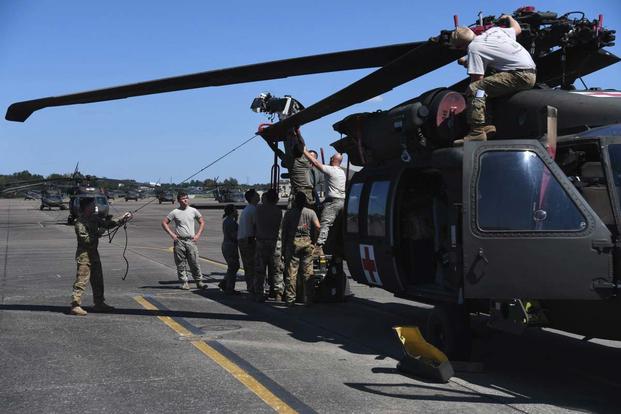The U.S. Army's 101st Airborne Division is positioning its helicopters to be used in search-and-rescue operations in the aftermath of Hurricane Irma.
The 101st Combat Aviation Brigade, based at Fort Campbell, Kentucky, will relocate more than 35 aircraft, 40 vehicles and 370 personnel to various locations in the affected area, according to Fort Campbell officials.
"Our thoughts and prayers are with those affected by Hurricane Irma," said Col. Craig J. Alia, 101st CAB commander, in a Sept. 11 press release.
"We are leaning forward now, proactively positioning our personnel and equipment to help the American people if called forward to support," he said. "Should local officials and emergency services need additional assets, we will be staged and prepared to go at a moment's notice."
Related content:
- Trump Hails Coast Guard Response to Irma
- Air Force Flies 300 Doctors to Florida for Irma Recovery
- Predator, Reaper Drones Flying to Monitor Harvey, Irma Aftermath
- Irma Hits Florida as Military Preps Massive Rescue Effort
- Aircraft Carrier Lincoln Heading to Florida for Irma Response
The move is part of the Defense Department's massive emergency relief effort that includes the arrival of the Nimitz-class aircraft carrier USS Abraham Lincoln off Florida's east coast Sunday night.
Irma, downgraded to a tropical storm, continued to weaken as it moved northwesterly into the southeastern U.S. on Monday.
Storm Aftermath
The Federal Emergency Management Agency estimated that nearly 5 million, or 34 percent, of Florida residents were without power.
The main water line into the Florida Keys was reported as being offline. Damage to the Keys may necessitate evacuation of the 10,000 people who did not evacuate prior to the storm, according to Army Lt. Col. Jamie Davis, a DoD spokeswoman.
The category 5 hurricane ripped through the Caribbean, killing 37 people on its way to Florida, where at least seven people have died.
"The Department of Defense is well postured with naval, air, and ground assets to initiate response operations in Florida today and will continue response operations throughout the Virgin Islands and Puerto Rico region," Davis said in a DoD press release.
The USS Kearsarge and USS Oak Hill continue to work in the Virgin Islands and Puerto Rico, moving people and supplies to the islands. Approximately 4,600 service members are supporting relief operations in the region.
An MV-22 Osprey aircraft assisted in the movement of British Marines from St. Croix to the British Virgin Islands.
Approximately 10,400 service members are supporting relief operations in the Florida region.
Search-and-Rescue Assets
U.S. Northern Command's main focus Monday was the pre-positioning of search-and-rescue assets in Florida should those capabilities be requested, according to a press release.
Military elements at Naval Air Station Key West and Homestead Air Reserve Base are assessing and re-establishing airfield operations for the possible employment of search-and-rescue assets.
U.S. Transportation Command is postured to airlift search-and-rescue assets staged in the United States around the storm as airfields become operational, and help move SAR assets returning from Puerto Rico, it said.
The U.S. Air Force's Air Mobility Command response personnel continue working to reopen airfields in Florida for use by military aircraft in assisting civil authorities' efforts to provide rapid humanitarian aid to those affected by Hurricane Irma, if requested. Air Force helicopters are also preparing for possible SAR operations.
The U.S. Navy continued to move the USS Iwo Jima and USS New York toward Key West. The Abraham Lincoln arrived Sunday night with 24 helicopters on board.
The 3rd Expeditionary Sustainment Command from Fort Bragg, North Carolina, is overseeing the Army's wheeled-vehicle effort, called Task Force Truck. The convoy has begun movement from Bragg with more than 100 high-water vehicles and nearly 400 soldiers. The high-water vehicles will be used in efforts to locate and rescue people who may be trapped by the flooding.
The Defense Logistics Agency is providing 76 fuel trucks at Robins Air Force Base, Georgia, with another 14 on the way. Additional supplies include 834 commodity trailers to support victims displaced by Irma. The agency is expected to distribute 12 million meals over the next 10 days, according Pentagon officials.
101st Airborne Ready to Assist
The 101st Airborne began preparing to assist with Irma on Sept. 7 by organizing potential response forces.
While the division received orders to reposition some of its forces, it has not yet been ordered to assist in the "Total Army's support to local, state and federal hurricane response efforts and the Defense Department's Defense Support of Civil Authorities mission," according to Fort Campbell officials.
However, the 101st is prepared to respond if necessary, officials maintain.
"The Army's readiness -- its ability to rapidly deploy trained and ready forces wherever they are needed -- is critical to protecting America, America's interests and American lives," said 101st Airborne spokesman Lt. Col. Martin L. O'Donnell. "Make no mistake, the 101st is ready."
-- Matthew Cox can be reached at matthew.cox@military.com.



























